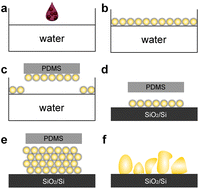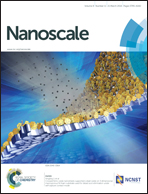Highly effective and uniform SERS substrates fabricated by etching multi-layered gold nanoparticle arrays†
Abstract
Gold nanoparticle multilayers printed on silicon substrates layer by layer were etched by a gold etchant to form highly effective and uniform substrates for surface-enhanced Raman scattering (SERS). The performance of the SERS substrates was systematically studied by adjusting the number of nanoparticle layers and the etching time. The optimized enhancement factor (EF) and the detection limit of the substrates were determined to be 8.6 × 106 and 1 × 10−12 M, respectively. The high EF and low detection limit were attributed to the high density of “hot-spots” and the facile accession of probe molecules to these spots. Moreover, the SERS substrates exhibited a nice uniformity with a small spot-to-spot variation and a good sample-to-sample reproducibility as well. The experimental results were supported by finite-difference time domain (FDTD) simulations. Our study suggests that low-cost, large-scale, and uniform SERS substrates with a high EF and low detection limit can be achieved by using bottom-up chemical methods.


 Please wait while we load your content...
Please wait while we load your content...